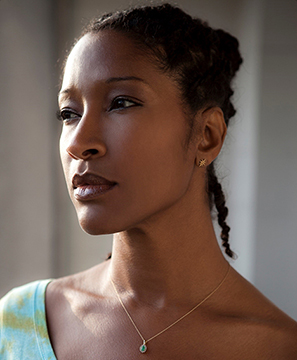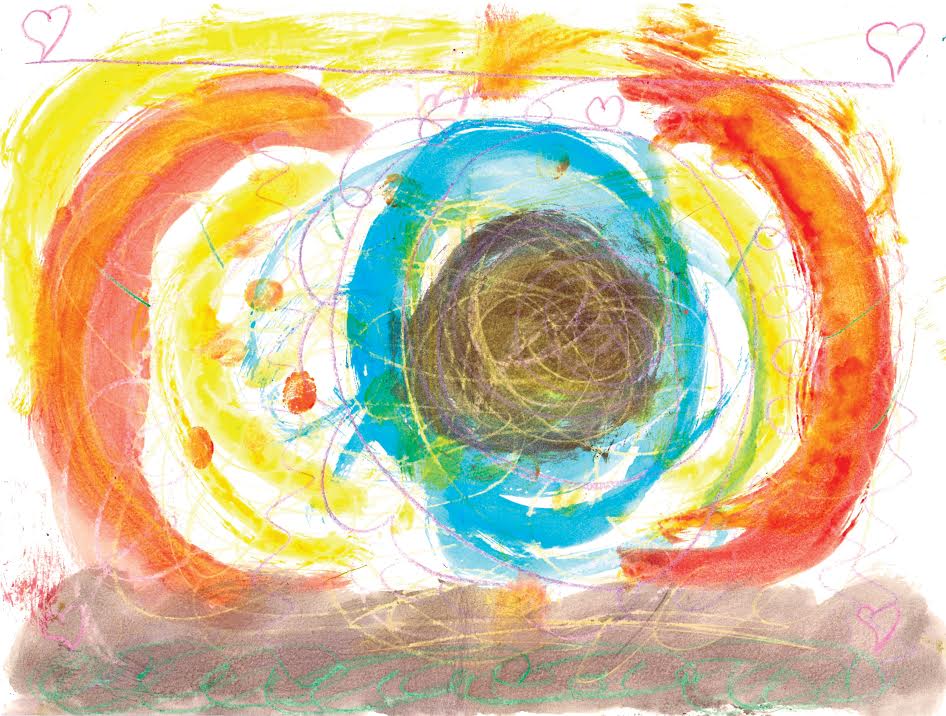When I started a fifth-grade writing workshop 20 years ago, I fired a lot of shots in the dark before I hit on an effective approach to teaching imagery-writing strategies, especially when it came to rendering sense of sight.
The prompts and feedback I used to offer in efforts to guide my students’ descriptions of what they or their characters see would generate laundry lists––i.e., I see a dog and a car and a sidewalk––more often than the vivid and dynamic sentences I was hoping for.
When I’d follow up by asking them to describe one of the nouns on their lists, I’d get more laundry lists of be verb-dependent adjectives––i.e., The dog is big and furry and brown.
Light can expose or hide, filter or catch, glimmer or fade. It’s everywhere—or nowhere—all the time . . .
Finally, I tweaked my teacher-talk. I ditched the word “describe,” and instead of asking kids what they see or what things look like, I started asking what things do. Sometimes this reframing would yield some well-muscled verbs. But not often enough. A lot of the time, kids would give me weird looks and say the dog and sidewalk aren’t doing anything. They’re just there.
“What about the stuff around your dog and sidewalk?” I’d eventually ask. This would prompt a few of my young writers to identify nearby objects (cars, traffic lights) or smaller parts of the thing they were writing about (the dog’s collar, the sidewalk’s crack), but some would insist their object was completely isolated, surrounded by nothing.
“Nothing is surrounded by nothing,” I finally said. “There’s always air. There’s always light.”
“Unless it’s night,” an especially observant student said.
“Ok,” I conceded. “There’s always light. Or darkness.”
A scene or stanza’s light (or its absence) shapes both tone and setting, builds tension, and adds dimension to character. Light can expose or hide, filter or catch, glimmer or fade. It’s everywhere––or nowhere––all the time, so it works as an on-ramp to any sensory description. Playing with light has become a way for my students to access the sort of shadow and nuance their laundry lists were shutting out.
Mining for Mentor Sentences
Lights, Camera, Action!
Over the years, I’ve collected a treasure trove of mentor sentences that model approaches to writing about light. Each time we read a novel in class, I pull out a few more shiny examples. This way, the kids have a sense of how the description of light works in connection to the characters and a sense of the scene’s mood.
Now, when I teach writing sense of sight, I show my students how mentor authors take on the challenge: they don’t list objects; they describe actions. Specifically, four kinds of action.
Let’s look at each one’s spin on our example draft: I see a dog and a car and a sidewalk . . .
4 Ways Light Can Move a Scene
Action 1: By doing something
Example: Headlights sweep across a dog in the road . . .
Action 2: By doing something human-like (personification)
Example: Moonlight mothers the dog to sleep . . .
Action 3: By people or things doing something in/to the light
Example: The dog’s whiskers catch the moonlight . . .
Action 4: By assuming shapes
Example: The dog sleeps in a pool of moonlight . . .
Action 1: What Light Does
To model techniques for showing us what light does to a scene’s characters or objects, Madeleine L’Engle’s classic, A Wrinkle in Time, never disappoints. Here’s a sentence from the middle of the novel:
The light spread until the patch of Dark Thing had vanished, and there was only a gentle shining. . . . Then, slowly, the shining dwindled until it, too, was gone.
The light here isn’t just “there.” It’s driving an action sequence: spreading, shining then dwindling, a development––then a disappearance––that powers the tension in this scene.
Another example of light and darkness as motion comes from Brian Selznick’s The Invention of Hugo Cabret:
He struck a match, watched it flare, and lit a few candles. The room filled with a warm golden glow, and huge shadows rose against the walls.
A lot of movement here: light flares and fills. At the same time, shadows (shapes of darkness) rise.
The student author of Black Hole tells me the story is fiction based on a real-life nightmare he once had. Here’s the first draft of one of its sentences:
You fear the sun won’t come back.
Pretty ominous start, but it’s all “telling.” No imagery that shows. “Come” is a hard verb to visualize. It’s not specific enough. When we workshopped this draft, I pulled out the Selnzick passage above, stressing its verbs, and then asked the author what the sun did in his nightmare.
After working out the details in a class discussion, he came up with this revision:
You fear the sun is crumbling to pieces this hot summer evening, grabbing everything.
Now we’ve got an image! The only light source in the world of this nightmare is crumbling and grabbing, taking everything in its glow down with it. Here’s the final revision as it appears in the published comic:

Action 2: Light Personified
This light writing technique is really a variation on the last one, “What Light Does.” The only difference is when light is personified, the thing it does is something humans do. Let’s look at some examples.
Here’s one from Cornelia Funke’s The Thief Lord:
Then he was swallowed by the shadows.
Swallowing is something people do, and swallowing other people is especially monstrous. The shadows in this scene don’t camouflage; they consume.
In this example from Phyllis Reynolds Naylor’s Shiloh, the darkness grows eyes:
I stare up into the darkness of the living room and the darkness stares back.
In this scene, the narrator tries to fall asleep in an unfamiliar house. By personifying the darkness, Naylor creates an especially haunting tone. This darkness is wide-eyed and alive!
The light in this (almost) haiku by a fourth-grade poet is an eye! Her final revision––along with the nebula that sparked her poem––that follows her draft below.
Here’s her first draft:
It looks like an eye.
Indeed, it does. But like an eye doing what? I asked the class when we workshopped the draft. In revision, this poet took a classmate’s suggestion to make her heavenly eye move. Now, it vanishes, glittery lashed, into the furry face of the cosmos:

With just this one verb, we get both tension and a turning point, arguably, all a poem really needs. The contrast between “heartless” and “glows” drives the theme home.
Action 3: What Things Do to Light
In Jewell Parker Rhodes’ Ghost Boys, I found several examples of objects doing things to (in, through, etc.) a scene’s light, including these two beauties:
Moths hover, batting their wings at the streetlights.
Ballerinas on the lampshade glow.
Compare these examples with “there are . . .” sentences that “tell” rather than “show,” like, There are moths around the streetlights, or There are ballerinas on the lampshade.
Static lines like these don’t reveal anything about tone or tension. The moths in Rhodes’s sentences hover and bat––move in vaguely threatening ways––like the trial at the heart of the novel. The warm lampshade fantasy here contrasts with the dark fate of the novel’s narrator.
In Jerry Spinelli’s Loser, the way light moves through darkness drives the novel’s climactic sequence:
Through the glittering snowfall he spots the Waiting Man glowing in his window . . .
Snowballs fly out of the darkness . . .
Police cars, emergency vehicles: a parade of them up the street, the snowy humps of parked cars pulsing in the swirling lights . . .
Compare these to static “telling” sentences like The police car lights are on, or The Waiting Man is in front of his window. They don’t give us the same sense of anticipation and dread that Spinelli’s prose does here.
Action 4: Shape-taking
The last “action category” is for mentor sentences that find shapes to hold their light or darkness. To see what I mean, take a look at this example from The Jumbies by Tracey Baptiste:
Pierre and Corinne . . . entered the churchyard just as the final rays of sunlight threw an orange veil over the world.
Here, sunlight is veil-shaped and also taking action––throwing its color over the world––so this one would fit into the first category, too.
When I share “shape sentences” like this one with my students, I always ask them to think of other shapes the author could have used and how those shapes would alter tone and meaning. For example, what if this sunlight covered the world with an orange scab or mask instead of a veil?
Another shape-of-light example, this one from Donna Barba Higuera’s The Last Cuentista:
Arcs of light blast out in all different directions . . .
Would this scene change if its light came in spear shapes instead?
For a writing exercise that challenged students to describe scenes in time-lapse videos, one third-grade poet wrote this sentence:
The weather will be nicer in May.
When we workshopped her draft with the class, I asked about what happens in May. “What’s the weather doing in May that’s ‘nicer’?” To answer my question, this poet used two light-describing strategies. Take a look at her final revision:

The light here is a conduit for sustenance, but also sharp enough to poke, a contrast this poet mirrors with “blades” and “reach.” Not only does her revision achieve the precision that effective tension-building demands, the personification here refines the image and sets it in motion. She brings May to life. Even though it’s February, and there’s still so much to learn.
Featured photo by Pixabay.
Robyn Carter is a writer, curriculum designer, and educator who’s been teaching writing to tweens for 20 years, most recently as a San Francisco WritersCorps Teaching Artist in Residence at a public elementary school in the City’s Tenderloin Neighborhood. Her ed writing has appeared in KQED in the Classroom and Teachers & Writers Magazine. Find her fiction in Conjunctions, Ninth Letter, Prime Number Magazine, and other journals. Her short story collection Impossible Object is forthcoming from Whiskey Tit Press.




